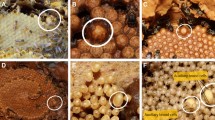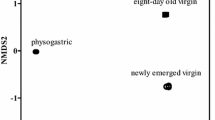Abstract
Stingless bees produce considerable numbers of virgin queens over the year, most of which are superfluous and get executed by the workers. Nothing is known yet about the sign stimulus that releases the worker attacks. In the present study we investigated the queen execution process in Melipona beecheii and found in both behavioral observations and experiments with caged living virgin queens that workers are not attracted to them from a distance by means of volatile chemicals. Furthermore, worker aggression, which is obvious towards virgin queens that run through the nest excitedly with their abdomen enlarged and the wings beating, was lowered to almost zero when we made the queens “behavior-less” by experimentally killing them. Our results clearly show that the sign stimulus for releasing the execution behavior in Melipona beecheii workers is not a chemical stimulus but the virgin queens’ conspicuous behavior, which, we hypothesize, could act as a direct measure of their fitness.
Zusammenfassung
Die hoch eusozialen stachellosen Bienen (Hymenoptera, Apidae, Meliponini) produzieren eine beträchtliche Anzahl junger Königinnen über das ganze Jahr hinweg (Michener, 1974; Sakagami, 1982). Die Mehrzahl der virginellen Königinnen sind jedoch überflüssig und werden von den Arbeiterinnen getötet (Engels und Imperatriz-Fonseca, 1990; Imperatriz-Fonseca und Zucchi, 1995). Obwohl das Verhalten der Bienen während der Exekution der Königinnen bereits mehrfach beschrieben wurde, ist über den Auslösereiz, der die Arbeiterinnenattacken verursacht, noch nichts bekannt. In der vorliegenden Studie haben wir deshalb untersucht, ob chemische Stoffe, die von den Königinnen abgegeben werden, und/oder deren auffallendes Verhalten, die Attacken der Arbeiterinnen bzw. das Töten der Jungköniginnen bei Melipona beecheii auslösen. Wir haben dazu Experimente in kleinen Beobachtungskästchen, die jeweils eine Brutwabe mit ca. 200 Zellen und 25–30 adulten Arbeiterinnen enthielten, durchgeführt. Jungköniginnen, die regungslos auf der Brutwabe saßen, wurden nie angegriffen. Sobald sie jedoch begannen mit vergrößertem (gestreckten) Abdomen umher zu laufen und mit ihren Flügeln zu schlagen, haben die Arbeiterinnen versucht sie zu packen (Abb. 2a), hauptsächlich am Abdomen (95,3 % der beobachteten Attacken). Sobald eine Arbeiterin es schaffte eine Königin an einem Bein, Flügel oder einer Antenne fest zu halten, haben ihr weitere Arbeiterinnen geholfen sie zu töten (Abb. 2b). Wenn wir attackierte Königinnen daran hinderten im Nest umher zu laufen, indem wir sie in kleine Käfige sperrten (Abb. 1), hat die Aggression der Arbeiterinnen ihnen gegenüber aufgehört. Käfige mit einer Jungköniginnen darin hatten nicht mehr Arbeiterinnen angelockt wie Käfige, die eine Arbeiterin enthielten oder leere Käfige. Auch die Zeit, die Arbeiterinnen auf solchen Käfigen verbrachten, war unabhängig von deren Inhalt (Kruskal-Wallis Tests, P > 0,05; Abb. 3). In einem zweiten Versuchsansatz haben wir über jeweils 10 Minuten die Anzahl aggressiver Arbeiterinnenkontakte gegenüber Jungköniginnen gezählt, welche (i) frei in einem Beobachtungskästchen herumliefen und (ii) dann von uns durch Einfrieren (2 Minuten bei −82 °C) getötet und auf die Brutwabe zurück gelegt wurden. Die Anzahl der Attacken auf die Königinnen hat sich durch das Töten und die damit einhergehende Unterbindung ihres auffallenden Verhaltens signifikant von 15 auf 0 (Mediane) verringert (Wilcoxon Test für Paardifferenzen, P = 0,008). Kein Verhaltensunterschied konnte jedoch festgestellt werden, wenn die Arbeiterinnen mit toten Jungköniginnen oder mit toten Arbeiterinnen konfrontiert waren (Mann-Whitney Tes t, P = 1,0; Abb. 4). Unsere Ergebnisse zeigen, dass Arbeiterinnen nicht durch volatile Duftstoffe aus größerer Entfernung zu den Jungköniginnen angelockt werden. Genauso wenig wird ihr aggressives Verhalten während den Exekutionen durch chemische Stoffe per se ausgelöst. Wir hypothetisieren, dass das auffallende Verhalten der virginellen Königinnen — und/oder dabei abgegebene Vibrationen bzw. Luftschallsignale — den Auslösemechanismus für die Arbeiterinnenattacken darstellen. Wir postulieren ferner, dass das Herumlaufen und schnelle Drehen der Jungkönigin als ehrliches Signal ihrer fitness dienen kann, da sie die Verfolgung durch die Arbeiterinnen für einige Zeit überleben müssen um schließlich als neue Königinnen akzeptiert zu werden.
Similar content being viewed by others
References
Abdalla F.C., Jones G.R., Morgan E.D., Cruz-Landim C. da (2003) Comparative study of the cuticular hydrocarbon composition of Melipona bicolor Lepeletier, 1836 (Hymenoptera, Meliponini) workers and queens, Gen. Mol. Res. 2, 191–199.
Ayasse M., Paxton R., Tengö J. (2001) Mating behavior and chemical communication in the Hymenoptera, Annu. Rev. Entomol. 46, 31–78.
Bourke A.F.G., Ratnieks F.L.W. (1999) Kin conflict over caste determination in social Hymenoptera, Behav. Ecol. Sociobiol. 46, 287–297.
Cruz-Landim C. da, Abdalla F.C., Gracioli-Vitti L.F. (2006) Class III glands in the abdomen of Meliponini, Apidologie 37, 164–174.
Darchen R., Delage-Darchen B. (1975) Contribution à l’étude d’une abeille du Mexique, Melipona beecheii B. (Hymenoptère: Apide), Apidologie 6, 295–339.
Engels W., Imperatriz-Fonseca V.L. (1990) Caste development, reproductive strategies, and control of fertility in honey bees and stingless bees, in: Engels W. (Ed.), Social insects: an evolutionary approach to castes and reproduction, Springer, Berlin, Heidelberg, New York, pp. 167–230.
Faustino C.D., Silva-Matos E.V., Mateus S., Zucchi R. (2002) First record of emergency queen rearing in stingless bees (Hymenoptera, Apinae, Meliponini), Insectes Soc. 49, 111–113.
Gilley D.C. (2001) The behavior of honey bees (Apis mellifera ligustica) during queen duels, Ethology 107, 601–622.
Guerino A.C., Oliveira V.T.P. de (2002) Glândulas tegumentares do abdomen, in: Cruz-Landim C. da, Abdalla F.C. (Eds.), Glândulas exócrinas das abelhas, FUNPEC-Editora, Ribeirão Preto, São Paulo, pp. 111–126.
Hartfelder K., Makert G.R., Judice C.C., Pereira G.A.G., Santana W.C., Dallacqua R., Bitondi M.M.G. (2006) Physiological and genetic mechanisms underlying caste development, reproduction and division of labor in stingless bees, Apidologie 37, 144–163.
Howard R.W., Blomquist G.J. (1982) Chemical ecology and biochemistry of insect hydrocarbons, Annu. Rev. Entomol. 27, 149–172.
Howard R.W., Blomquist G.J. (2005) Ecological, behavioural, and biochemical aspects of insect hydrocarbons, Annu. Rev. Entomol. 50, 371–393.
Imperatriz-Fonseca V.L., Zucchi R. (1995) Virgin queens in stingless bees (Apidae, Meliponinae) colonies: a review, Apidologie 26, 231–244.
Jarau S., Twele R., Francke W., Aguilar I., van Veen J., Ayasse M. (2006) Queen signal of the stingless bee Melipona beecheii (Apidae, Meliponini), Proc. XV. IUSSI Congr., Washington, DC, p. 226.
Kerr W.E. (1948) Estudos sôbre o gênero Melipona, An. Esc. Sup. Agricult. “Luiz de Queiroz” 5, 181–276.
Kerr W.E. (1950) Genetic determination of castes in the genus Melipona, Genetics 35, 143–152.
Kerr W.E. (1969) Some aspects of the evolution of social bees (Apidae), Evol. Biol. 3, 119–175.
Kerr W.E. (1974) Sex determination in bees. III. Caste determination and genetic control in Melipona, Insectes Soc. 21, 357–368.
Kerr W.E., Nielsen R.A. (1966) Evidences that genetically determined Melipona queens can become workers, Genetics 54, 859–866.
Kerr W.E., Zucchi R., Nakadaira J.T., Butolo J.E. (1962) Reproduction in the social bees (Hymenoptera: Apidae), J. N.Y. Entomol. Soc. 70, 267–276.
Kerr W.E., Stort A.C., Montenegro M.J. (1966) Importância de alguns fatôres ambientais na determinação das castas no gênero Melipona, An. Acad. Bras. Ciênc. 38, 149–168.
Kerr W.E., Jungnickel H., Morgan E.D. (2004) Workers of the stingless bee Melipona scutellaris are more similar to males than to queens in their cuticular compounds, Apidologie 35, 611–618.
Kleinert A. de M.P. (2005) Colony strength and queen replacement in Melipona marginata (Apidae: Meliponini), Rev. Bras. Biol. 65, 469–476.
Kleinert A. de M.P., Imperatriz-Fonseca V.L. (1994) Virgin queens refuges in colonies of Melipona marginata (Apidae, Meliponinae), Rev. Bras. Biol. 54, 247–251.
Koedam D. (1995) Behavioural and physiological implications of queen dominance in stingless bees, Ph.D. thesis, Utrecht University, The Netherlands.
Koedam D. (1999) Production of queens, workers and males in the stingless bee Melipona favosa (Apidae: Meliponinae): patterns in time and space, Neth. J. Zool. 49, 289–302.
Koedam D., Aguilar Monge I., Sommeijer M.J. (1995) Social interactions of gynes and their longevity in queenright colonies of Melipona favosa (Apidae: Meliponinae), Neth. J. Zool. 45, 480–494.
Kucharski R., Maleszka J., Foret S., Maleszka R. (2008) Nutritional control of reproductive status in honeybees via DNA methylation, Science 319, 1827–1830.
Michener C.D. (1974) The social behavior of the bees: a comparative study, Belknap Press of Harvard University Press, Cambridge, Massachussets.
Monnin T. (2005) Chemical recognition of reproductive status in social insects, Ann. Zool. Fenn. 43, 515–530.
Moo-Valle H., Quezada-Euán J.J.Q., Wenseleers T. (2001) The effect of food reserves on the production of sexual offspring in the stingless bee Melipona beecheii (Apidae, Meliponini), Insectes Soc. 48, 398–403.
Moo-Valle H., Quezada-Euán J.J.Q., Canto-Martín J., Gonzalez-Acereto J.A. (2004) Caste ontogeny and the distribution of reproductive cells on the combs of Melipona beecheii (Apidae: Meliponini), Apidologie 35, 587–594.
Morais M.M., Nascimento F.S., Pereira R.A., Bego L.R. (2006) Colony internal conditions related to caste production in Melipona compressipes fasciculata (Apidae, Meliponini), Insectes Soc. 53, 265–268.
Pflugfelder J., Koeniger N. (2003) Fight between virgin queens (Apis mellifera) is initiated by contact to the dorsal abdominal surface, Apidologie 34, 249–256.
Ratnieks F.L.W. (2001) Heirs and spares: caste conflict and excess queen production in Melipona bees, Behav. Ecol. Sociol. 50, 467–473.
Sakagami S.F. (1982) Stingless bees, in: Hermann H.R. (Ed.), Social insects, Vol. 3, Academic Press, New York, pp. 361–423.
Sakagami S.F., Oniki Y. (1963) Behavior studies of the stingless bees, with special reference to the oviposition process. I. Melipona compressipes manaosensis Schwarz, J. Fac. Sci. Hokkaido Univ. Ser. VI Zool. 15, 300–318.
Sakagami S.F., Montenegro M.J., Kerr W.E. (1965) Behavior studies of the stingless bees, with special reference to the oviposition process. V. Melipona quadrifasciata anthidioides Lepeletier, J. Fac. Sci. Hokkaido Univ. Ser. VI Zool. 15, 578–607.
Santos-Filho P. de S., Alves D. de A., Eterovic A., Imperatriz-Fonseca V.L., Kleinert A. de M.P. (2006) Numerical investment in sex and caste by stingless bees (Apidae: Meliponini): a comparative analysis, Apidologie 37, 207–221.
Silva D.L.N. da, Zucchi R., Kerr W.E. (1972) Biological and behavioural aspects of the reproduction in some species of Melipona (Hymenoptera, Apidae, Meliponinae), Anim. Behav. 20, 123–132.
Singer T.L. (1998) Roles of hydrocarbons in the recognition systems of insects, Am. Zool. 38, 394–405.
Sommeijer M.J., de Bruijn L.L.M., Meeuwsen F.J.A.J., Martens E.P. (2003a) Natural patterns of caste and sex allocation in the stingless bees Melipona favosa and M. trinitatis related to worker behaviour, Insectes Soc. 50, 38–44.
Sommeijer M.J., de Bruijn L.L.M., Meeuwsen F.J.A.J., Slaa E.J. (2003b) Reproductive behaviour of stingless bees: nest departures of non-accepted gynes and nuptial flights in Melipona favosa (Hymenoptera: Apidae, Meliponini), Entomol. Berichten 63, 7–13.
Sommeijer M.J., de Bruijn L.L.M., Meeuwsen F.J.A.J. (2003c) Reproductive behaviour of stingless bees: solitary gynes of Melipona favosa (Hymenoptera: Apidae, Meliponini) can penetrate existing nests, Entomol. Ber. 63, 31–35.
Sramkova A., Schulz C., Twele R., Francke W., Ayasse M. (2008) Fertility signals in the bumblebee Bombus terrestris (Hymenoptera: Apidae), Naturwissenschaften 95, 515–522.
Tarpy D.R., Gilley D.C. (2004) Group decision making during queen production in colonies of highly eusocial bees, Apidologie 35, 207–216.
van Veen J.W. (2000) Cell provisioning and oviposition in Melipona beecheii (Apidae, Meliponinae), with a note on caste determination, Apidologie 31, 411–419.
van Veen J.W., Sommeijer M.J., Aguilar Monge I. (1999) Behavioural development and abdomen inflation of gynes and newly mated queens of Melipona beecheii (Apidae, Meliponinae), Insectes Soc. 46, 361–365.
Wenseleers T., Ratnieks F.L.W., Billen J. (2003) Caste fate conflict in swarm-founding social Hymenoptera: an inclusive fitness analysis, J. Evol. Biol. 16, 647–658.
Wenseleers T., Hart A.G., Ratnieks F.L.W., Quezada-Euán J.J.G. (2004) Queen execution and caste conflict in the stingless bee Melipona beecheii, Ethology 110, 725–736.
Wilson E.O. (1971) The insect societies, The Belknap Press of Harvard University Press, Cambridge, Massachussets, London.
Author information
Authors and Affiliations
Corresponding author
Additional information
Manuscript editor: Yves Le Conte
Rights and permissions
About this article
Cite this article
Jarau, S., Van Veen, J.W., Aguilar, I. et al. Virgin queen execution in the stingless bee Melipona beecheii: The sign stimulus for worker attacks. Apidologie 40, 496–507 (2009). https://doi.org/10.1051/apido/2009022
Received:
Revised:
Accepted:
Issue Date:
DOI: https://doi.org/10.1051/apido/2009022




